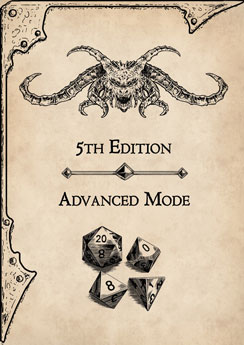Large beast (giant animal), unaligned
Armor Class 14 (Natural Armor)
Hit Points 60 (8d10 + 16)
Speed 30 ft., burrow 10 ft.
Proficiency Bonus +2
Proficiency Bonus +4 (5th Edition Advanced Mode)
| STR | DEX | CON | INT | WIS | CHA |
|---|---|---|---|---|---|
| 19 (+4) | 7 (-2) | 15 (+2) | 1 (-5) | 14 (+2) | 3 (-4) |
Skills Perception +4, Stealth +4 (+8 when hiding in the pit trap)
Senses tremorsense 240 ft., passive Perception 12
Languages –
Challenge 3 (700 XP)
Pit Trap. The ant lion choses a site and dig its pit trap. When a target comes within 10 feet of the pit, the antlion starts to crawl backwards, using its abdomen as a plough to shovel up the soil. The target must make a successful DC 14 Dexterity check or fall straight into the ant lion’s mouth. This ability allows the ant lion to automatically score a hit and inject its poison.
ACTIONS
- Bite. Melee Weapon Attack: +6 to hit, reach 10 ft., one target. Hit: 15 (5d4 + 3) piercing damage plus 3 (1d6) acid damage plus 3 (1d6) poison damage. The target must make a DC 10 Constitution saving throw or suffer the poisoned condition for 1 minute. If the target is a Large or smaller creature, it is grappled (escape DC 15). Until this grapple ends, the ant lion can bite only the grappled creature and has advantage on attack rolls to do so.
5th Edition Advanced Mode
Limiting the power of a character and making the overall difficulty of the game harder, does not reduce the creativity, indeed it does quite the opposite.
The Game Master has the option to use any and all of the instances proposed in this guide, or just some of them according to their preference.
It is the lack of something that move and motivate characters, not the abundance of it
DESCRIPTION
A giant ant lion is a monstrous insect that resembles a huge ant with an oversized abdomen. It has a pair of long, hooked mandibles that can tear through flesh and armor with ease. Its body is covered with a hard exoskeleton that protects it from attacks. A giant ant lion can grow up to 10 feet long and weigh up to 2,000 pounds.
COMBAT
A giant ant lion is a cunning predator that uses its burrowing ability to create traps for its prey. It digs a conical pit in sandy or gravelly terrain, then hides at the bottom, waiting for unsuspecting creatures to fall in. When a victim slides down the loose sides of the pit, the giant ant lion strikes with its mandibles, dealing massive damage and grappling the target. A giant ant lion can also spit acid at foes that are out of reach, causing severe burns.
A giant ant lion is not very agile, but it can use its tremorsense to detect the movements of nearby creatures. It prefers to fight in its lair, where it has the advantage of terrain and surprise. If threatened or outnumbered, it may retreat into its burrow or flee to another location.
HABITAT / SOCIETY
A giant ant lion is a solitary creature that lives in arid or desert regions. It does not have a fixed territory, but wanders in search of food and suitable places to dig its pits. A giant ant lion does not have any social or mating behavior, and only encounters others of its kind during rare migrations or invasions.
A giant ant lion is not intelligent, but it has a keen instinct for survival and hunting. It can adapt to different environments and prey, and may even learn from its mistakes or successes. A giant ant lion may also develop a taste for certain types of creatures, such as humans, elves, or horses, and target them preferentially.
ECOLOGY
A giant ant lion is a voracious carnivore that feeds on any creature it can catch and kill. It can consume up to half its body weight in a single meal, and may store excess food in its abdomen for later use. A giant ant lion does not have any natural predators, except for other giant insects or larger monsters. It may also compete with other burrowing creatures, such as ankhegs or bulettes, for food and space.
A giant ant lion plays an important role in the ecosystem of its habitat. It helps to aerate the soil and recycle organic matter by digging its pits and devouring its prey. It also serves as a source of food and materials for other creatures. Some desert tribes may hunt giant ant lions for their meat, chitin, acid glands, or mandibles. Some adventurers may also seek them out for their challenge or treasure.
